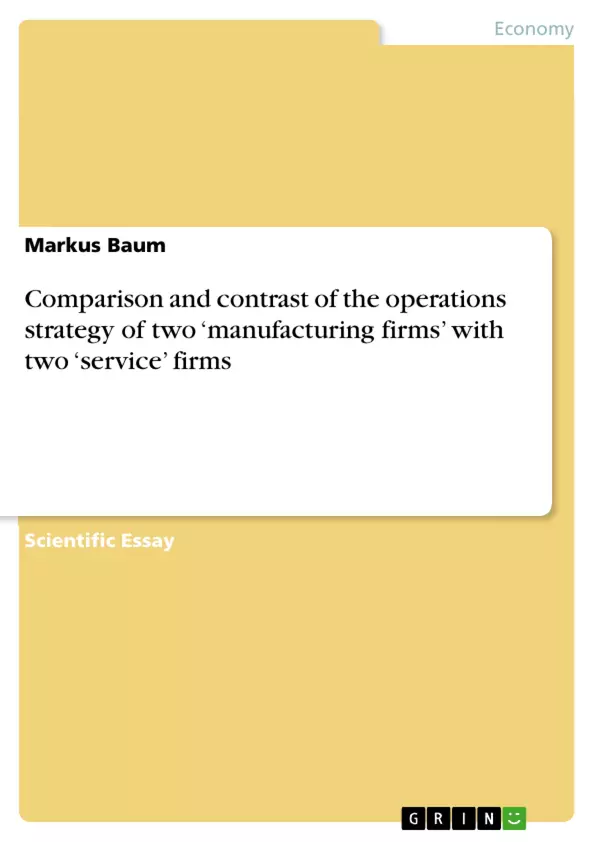INTRODUCTION:
The purpose of this paper is to compare and contrast the operations strategy of two ‘manufacturing firms’ with two ‘service’ firms and to evaluate the order qualifying and order winning criteria.
Operations strategy is one part of an enterprise’s overall strategy (corporate strategy, business strategy and operational strategy) and defines the enterprise adjustment concerning “core competencies, capabilities and processes, technologies, resources and key tactical activities necessary in any supply network, in order to create and deliver products or services and the value demanded by a customer” (Lowson, 2001).
CONCLUSION:
The analysis of two manufacturing (Dell, Zara) and two service firms (Lufthansa, McDonalds) shows the correspondence between the theoretical approach of operations management and current practice. Each company has a whole enterprise strategy that includes the operations strategy. Each industry has different order qualifiers, but no company analyzed was able to be the best in all qualifiers, which supports the theoretical conclusion that fulfilling all objectives simultaneously, is impossible (Skinner, 1969).
AUTHOR:
Markus Baum is Group Finance Director at a management consulting (Germany) firm with focus on business strategy, supply chain management (SCM), manufacturing & logistics, sourcing & purchasing, marketing & sales, financial management and information technology (IT-strategy). The company has subsidiaries in Germany, Switzerland, Belgian, France, United Kingdom and Russia.
Markus Baum earned a MBA with distinction from the University of Surrey (UK), is an international certified accountant, has and graduation in accounting & controlling and an apprenticeship as tax adviser assistant. Markus Baum is a member of the International Controlling Association.
Table of Contents
- 1. INTRODUCTION, THEORETICAL BACKGROUND AND DEFINITIONS
- 2. CASE ANALYSIS.
- 2.1 Dell Incorporated (Dell).
- 2.1.1 Company Profile, Industry and Environment.
- 2.1.2 Order Qualifiers
- 2.1.3 Order Winners
- 2.1.4 Operations Strategy...
- 2.2 Zara Trading Incorporated (Zara)...
- 2.2.1 Company profile, Industry and Environment.
- 2.2.2 Order Qualifiers
- 2.2.3 Order Winners
- 2.2.4 Operations Strategy...
- 2.3 McDonalds Corporation (McDonalds).
- 2.3.1 Company profile, Industry and Environment.
- 2.3.2 Order Qualifiers
- 2.3.3 Order Winners
- 2.3.4 Operations Strategy.
- 2.4 Deutsche Lufthansa AG (Lufthansa)
- 2.4.1 Company profile, Industry and Environment
- 2.4.2 Order Qualifiers
- 2.4.3 Order Winners
- 2.4.4 Operations Strategy...
- 3. CONCLUSION
Objectives and Key Themes
This paper aims to compare and contrast the operations strategy of two manufacturing firms with two service firms, evaluating their order qualifying and order winning criteria. It explores the concept of operations strategy as a component of an enterprise's overall strategy and examines how it influences the development of core competencies, capabilities, processes, technologies, resources, and key tactical activities within a supply network.
- Operations strategy as a component of overall enterprise strategy
- Order qualifying and order winning criteria for different types of companies
- Comparison and contrast of operations strategies across manufacturing and service firms
- The role of core competencies, capabilities, and resources in operational success
- The impact of operational strategy on customer value and satisfaction
Chapter Summaries
The first chapter introduces the concept of operations strategy, its role within an enterprise's overall strategy, and key definitions. It also outlines the theoretical framework and relevant literature.
The second chapter presents case studies of four companies: Dell Incorporated (a manufacturing firm), Zara Trading Incorporated (a manufacturing firm), McDonalds Corporation (a service firm), and Deutsche Lufthansa AG (a service firm). Each case study provides an in-depth analysis of the company's profile, industry and environment, order qualifying criteria, order winning criteria, and operations strategy.
The third chapter concludes the paper by summarizing the findings from the case studies and drawing insights about the similarities and differences in operations strategy between manufacturing and service firms.
Keywords
Operations strategy, manufacturing firms, service firms, order qualifying criteria, order winning criteria, core competencies, capabilities, resources, supply network, customer value, customer satisfaction, competitive factors, performance objectives, case studies, Dell, Zara, McDonalds, Lufthansa.
- Quote paper
- Markus Baum (Author), 2011, Comparison and contrast of the operations strategy of two ‘manufacturing firms’ with two ‘service’ firms, Munich, GRIN Verlag, https://www.grin.com/document/193738



